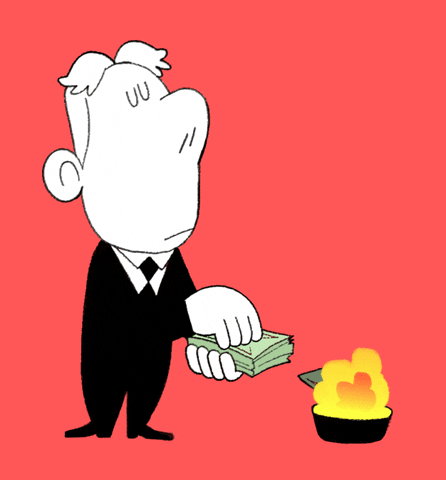Good evening, everyone. The stock market was a whirlwind again. 🌪️
Each index closed in negative territory after yesterday’s beating. The Russell 2000 plunged 2.3% for its third consecutive loss. The Nasdaq dropped 1.4% and the S&P 500 surrendered 0.54%.
Tesla tanked 11.5% after reporting earnings last night. 👎 $TSLA is down 21.6% YTD. Here’s the daily chart:
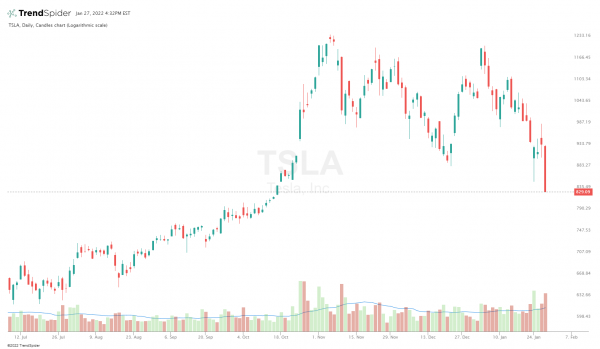
The sectors traded mixed. Energy extended 1.1% while utilities followed, gaining 0.89%. Consumer discretionary collapsed 2.42% and real estate decreased 1.8%.
Crypto cruised lower. Ethereum dove 4% and Bitcoin busted 1.6%.
Robinhood Markets got hoodwinked and the stock flopped 9.8% after hours. 😬 Read more below.
$GLPG galloped 22.47%, $SIDU soared 31.55%, and $LMPX leaped 20.7%.
Here are the closing prices:
| S&P 500 | 4,326 | -0.54% |
| Nasdaq | 13,352 | -1.40% |
| Russell 2000 | 1,931 | -2.29% |
| Dow Jones | 34,160 | -0.02% |
Earnings
R.I.P to Robinhood
Usually, we’d take the most “prominent” earnings in any given day for our top story. However, there’s just one story we cannot ignore today. Robinhood’s down 12.2% in afterhours because of earnings-related antics… (sorry Apple!)
Robinhood has been in decline for months. So what’s with this collapse? 🤔 Here’s the post-mortem from today’s earnings report:
Revenue: $362.7 million, +14% YoY (analysts expected $370.9 million)
Earnings loss per share: -$0.49 per diluted share (analysts expected -$0.45)
Net loss before income tax: $420 million, -2,310% YoY (analysts expected $362.1 million)
Monthly active users (MAUs): 17.3 million (down from 18.9 million in Q3; analysts expected 19.8 million.)
Those four bullet points pretty much outline everything wrong with Robinhood — things are going in the wrong direction. The company’s stock price makes that abundantly clear. 💀
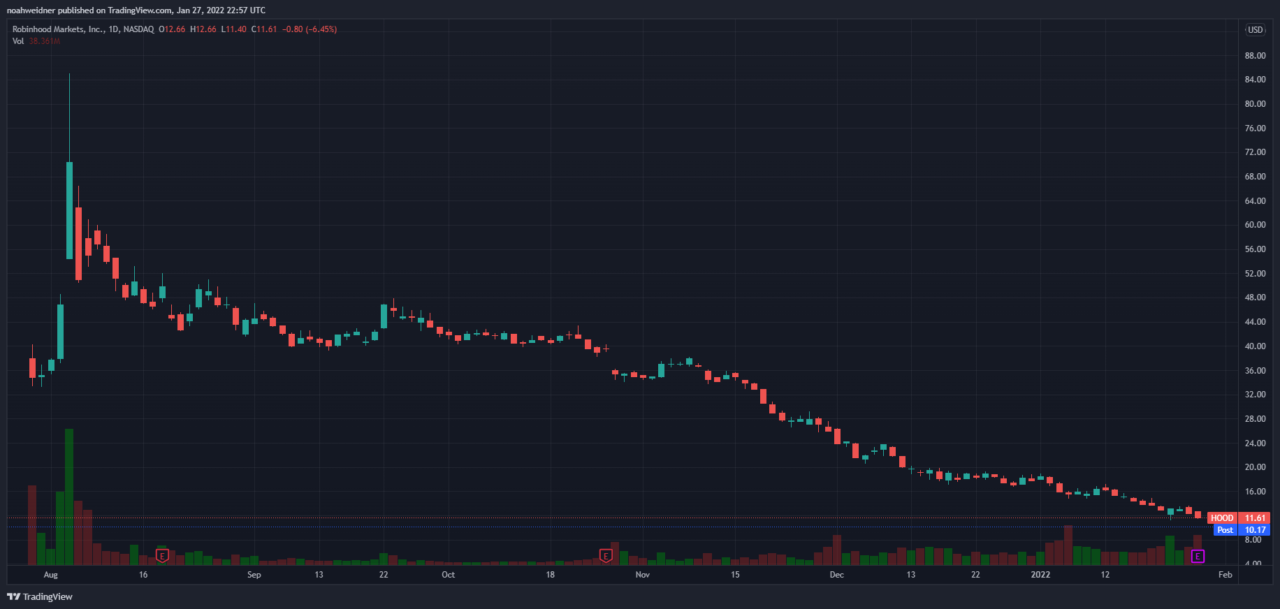
Robinhood hopes it can turn its stock around with the long-awaited launch of crypto wallets. The platform presumably plans to add more pairs to trade than legacy cryptos, sh*tcoins, and Bitcoin/Ethereum. After all, transactions are how Robinhood makes most of its money. The problem is that equities and crypto-related trading are just not hitting like they used to, and the company is leaning on its options trading transaction revenues as a crutch.
Even then, everything about the company is behind where it was when the retail revolution was in vogue. That’s why the next two quarters could continue to test Robinhood’s (and its investors’) patience. The company will face its most aggressive comps in recent history in Q1 and Q2 (remember GameStop and Dogecoin?)
With that said, if investors like Robinhood at $85, they’ll probably love it at suppressed price points. It’s too early to call a bottom, but with the company worth less than $10 billion, it’s not out of the question that Robinhood could stage a recovery — or potentially get acquired by a large legacy player looking for a way to step into the fintech world. (Until we see more action, we’re betting the latter might be true.) 🎲
$HOOD is down 66.6% since IPO. Oof.
Sponsored
Invest in the Company Reinventing Digital Health in a $480B Industry
NowRx is disrupting the $480B retail pharmacy industry with amazing customer service and free same day pharmacy delivery.
In 2021, NowRx achieved $26M+ in annualized revenue, including their newest telehealth service which grew by over 1,200% from Q1 to Q4.
Best of all the company operates at a fraction of the cost of major retail chains and has already announced 3 new locations for early 2022.
Don’t miss your opportunity to own shares in this rapidly growing startup. Invest in NowRx today.
Earnings
Earnings
While we’re on earnings, there were a lot of them today. Let’s take a look at what else was on deck.
Apple ascended 3.3% in extended-trading, smashing earnings estimates in the fourth-quarter. $AAPL’s revenue spiked 11% to $123.9 billion, setting a new record high. 🏆
$AAPL | EPS: $2.10 (vs. $1.89 expected) | Revenue: $123.9 billion (vs. $118.66 billion expected) | Link to Report
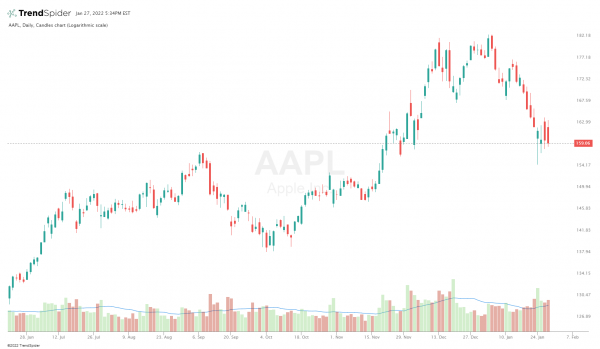
Visa vaulted 5% after exceeding earnings and sales expectations. Revenue, net income, and EPS all increased by at least 24%, and revenue surpassed $7 billion for the first time.
$V | EPS: $1.81 (vs. $1.69 expected) | Revenue: $7.06 billion (vs. $6.79 billion expected) | Link to Report
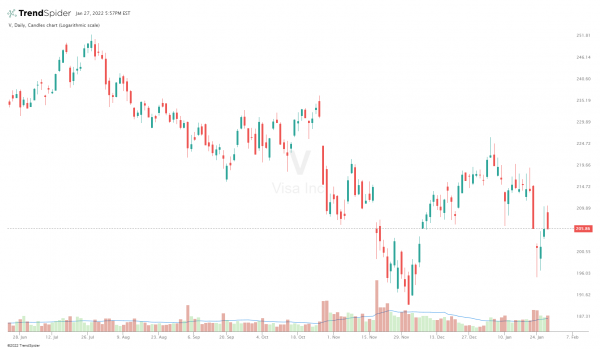
Atlassian accelerated 10% after the collaboration software company announced second-quarter profits above forecasts and boosted its subscription revenue outlook. $TEAM expects subscription revenue to rise 50% for the full fiscal year.
$TEAM | EPS: $0.50 (vs. $0.39 expected) | Revenue: $688.5 million (vs. $641.3 million expected) | Link to Report
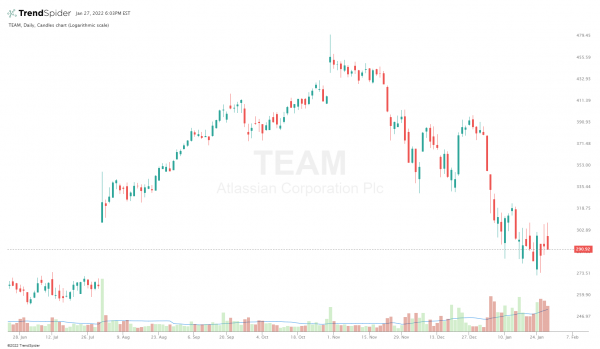
Didn’t see something you think you should have? Don’t worry. We probably have it on the Stocktwits earnings calendar. 📅 Check it out!!
The Fed announced yesterday that interest rates are going up, and now the stock market’s going down… but why?? What the heck does the Fed have to do with interest rates, anyway? 🤔
For the unacquainted who’ve seen us talking about the importance of the Fed for a year, our obsession with interest rates might seem like infatuation. 😍 But that’s because interest rates affect many aspects of life in a country, its economy, and its markets. Let’s examine why:
- The Federal Reserve controls the federal funds rate (this ‘interest rate’ JPow talks about), which is the target interest rate at which commercial banks can lend their reserves to each other. A bank’s reserves describe the cash that banks have to keep in actual vaults to make sure they have enough liquid money to satisfy a large withdrawal. The federal funds rate is important because it affects unemployment, economic growth, and inflation in the U.S. 🚨
- The federal funds rate affects other interest rates that you may be familiar with, such as interest rates on home or auto loans. 🚗 🏡Why does this relationship exist? Well, because the interest rate at which you have to pay back your car loan depends on the bank’s individual rate for you (this is known as the prime lending rate), and your individual rate is directly related to the federal funds rate.
- You probably heard yesterday that the Fed is going to ‘reduce its balance sheet’ and ‘raise rates.’ When the federal funds rate is low, it encourages people to invest or take out loans (because you have less interest to pay back.) That’s why the Fed lowered rates during the pandemic in an effort to incentivize people to participate in the economy in spite of lockdowns. The Fed also started buying bonds and other securities — ‘increasing the size of its balance sheet’ — in a process called quantitative easing to help lower interest rates.
- Although lowering rates and increasing asset purchases was an appropriate short-term monetary response to the pandemic-era economy, low rates and printing lots of money causes inflation in the long run, which is where we are now.
- So if raising rates helps combat inflation, why is the stock market reacting negatively? Because higher interest rates raise borrowing costs, disincentivize hiring, increase credit card rates, and generally slow down the economy (at least, temporarily.) And when the economy slows down, bonds become more appealing investments because they’re less risky — so investors are selling or switching to bonds to avoid losing money. 💡
At the end of the day, the Fed is reacting to inflation in a way that’s historically appropriate. The market just isn’t happy because, in the words of JPMorgan analyst David Stubbs, “What the market doesn’t like, is rapid changes in the monetary landscape.” 🤷
Company News
Boeing Considers New Jet Tech
Boeing has reportedly begun planning for its next-generation airplane. The design could mark a departure from the aviation industry’s reliance on “tube-and-turbofan” design. ✈️
According to Bloomberg, Boeing is in the extremely early days of developing the new airliner. Boeing’s European competitor, Airbus, is reportedly considering a fleet of hydrogen-powered aircraft, while engine players such as General Electric and Rolls Royce are trying to stay relevant by working on “several futuristic engine technologies” that would cut fuel consumption to the score of double-digits.
Ultimately, new designs might be a “wait and see” for Boeing, which claims the company is “not resting and standing still.” Novel, unproven technology could be a risky choice for a company with a record of building planes that fall out of the sky and cutting quality assurance corners. 😬 On the other hand, an innovative, game-changing solution for airlines could revolutionize the industry, putting Boeing’s star back in the sky. 🌟
$BA is down 3.7% over the last year. The company has gained just 16.8% in the past five years.
Bullets
Bullets from the Day
Some random BlackRock ETF just saw $3.7 billion in inflow today…? For 15 years the iShares MSCI Kokusai ETF, which tracks large and mid-cap stocks across the globe, has seen little action. Today, however, the ETF received $3.7 billion in inflow out of nowhere. Bloomberg ETF analysts commented “The $3.7 billion into a fund on one day when the fund previously had just $184 million in AUM is a strange move and definitely an outlier. It seems like it may be a model portfolio move because it’s so large and so specific.” Read more in Bloomberg.
The Joe Rogan/Spotify/Neil Young drama continues. Early this week, singer Neil Young made quite the ultimatum to Spotify — “keep Joe Rogan or me. It can’t have both on the service.” Young removed his music from Spotify yesterday, saying “I am doing this because Spotify is spreading fake information about vaccines — potentially causing death to those who believe the disinformation being spread by them.” The only problem is that Joe Rogan’s podcast is a money-making machine, and Spotify knows that it can’t afford to lose Rogan’s audience. Read more in The Verge.
Tesla announced during its Q4 earnings that its most important new product is a humanoid robot. Yeah, what?? The company said that it doesn’t plan to release Cybertruck or make a $25,000 car in 2022. Instead, Elon emphasized the importance of developing Tesla’s robot, named ‘Optimus.’ Elon shared “[Optimus is] intended to be friendly, of course, and navigate through a world of humans, and eliminate dangerous, repetitive and boring tasks.” Read more in CNBC.
Links
Links That Don’t Suck:
💰 Invest in the company that grew to over $26M in annualized revenue in 2021.*
🚓 San Francisco’s Historic Surveillance Law May Get Watered Down
🥃 Don Julio Tequila Maker Diageo Is Running Low on Booze That Takes Years to Make
📱 FCC Unanimously Approves ‘Nutrition Labels’ for Broadband Services
🚗 How to Winter-Proof Your Tesla
💀 Crypto Leads to Massive Surge in Online Scams
💡 Should You Max Out Your 401(k) Earlier in the Year?
*this is a sponsored post


